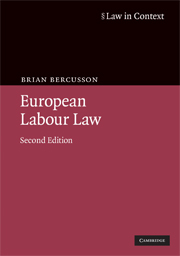Book contents
- Frontmatter
- Contents
- Preface
- Section I Labour law and Europe
- Section II The structure of European labour law
- Section III The futures of European labour law
- 20 The futures of European labour law: (1) the Commission's agenda – ‘modernisation’
- 21 The futures of European labour law: (2) the European Court's agenda and ordre communautaire social
- 22 The futures of European labour law: (3) the agenda of the Member States and of the European Parliament – the Lisbon Treaty and after
- Index
- References
20 - The futures of European labour law: (1) the Commission's agenda – ‘modernisation’
from Section III - The futures of European labour law
Published online by Cambridge University Press: 05 June 2012
- Frontmatter
- Contents
- Preface
- Section I Labour law and Europe
- Section II The structure of European labour law
- Section III The futures of European labour law
- 20 The futures of European labour law: (1) the Commission's agenda – ‘modernisation’
- 21 The futures of European labour law: (2) the European Court's agenda and ordre communautaire social
- 22 The futures of European labour law: (3) the agenda of the Member States and of the European Parliament – the Lisbon Treaty and after
- Index
- References
Summary
Introduction: the futures of European labour law
The future of European labour law is part of the unfolding dynamic of European integration in which the political, economic and social context is critical. In particular, the institutional balance among the EU institutions and the Member States, an\d between them, is crucial. In this, European labour law is not so different from domestic labour laws, also contingent on national political, economic and social contexts and state and societal structures. But, as has been emphasised throughout this book, it is important to see EU law, and in particular European labour law, as not exclusively the province of states and EU institutions. Sub-national and supranational actors also play a role and the EU institutions and the Member States are all subject to the pressures of interest groups, not least trade unions and employers' organisations.
This is also the case of the European Court of Justice, where litigation strategy plays a role in determining which issues come to the fore. The consequences of litigation may also affect the future of European labour law. In two cases decided by the European Court of Justice at the end of 2007 – the Viking case, referred by the English Court of Appeal and the Laval case, referred by the Swedish Labour Court – the issue raised was whether EU law includes a fundamental right to take collective action, including strike action, as declared in Article 28 of the EU Charter of Fundamental Rights.
- Type
- Chapter
- Information
- European Labour Law , pp. 639 - 654Publisher: Cambridge University PressPrint publication year: 2009

